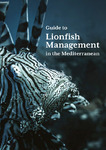Guide to Lionfish Management in the Mediterranean
| dc.contributor.author | Kleitou, P | |
| dc.contributor.author | Hall-Spencer, Jason | |
| dc.contributor.author | Rees, Sian | |
| dc.contributor.author | Kletou, D | |
| dc.contributor.other | 60% funded by the EU LIFE programme (LIFE16 NAT/CY/000832), 40% by University of Plymouth | |
| dc.date.accessioned | 2022-04-08T14:16:07Z | |
| dc.date.issued | 2022-04-08 | |
| dc.identifier.citation |
Kleitou, P., Hall-Spencer, J., Rees, S., Kletou, D. (2022). | |
| dc.identifier.isbn | 978-1-84102-458-5 | |
| dc.identifier.uri | http://hdl.handle.net/10026.1/19025 | |
| dc.description | File replaced (incorrect version) on 20/04/2022 by KT (LDS). | |
| dc.description.abstract |
Lionfish (Pterois miles) are spreading in the fastest fish invasion ever reported in the Mediterranean Sea where they are disrupting ecosystems and have the potential to impact livelihoods. First found in Lebanon in 2012, lionfish quickly became established throughout the eastern Mediterranean and are now spreading west. This management guide is based on lessons learnt during the European Union part-funded RELIONMED project which started in 2017. Local citizen scientists, stakeholders, divers, fishers, researchers and managers worked together to tackle the lionfish threat to conserve biodiversity in priority habitats. This Guide is designed to inform lionfish management in the Mediterranean region, key topics include (1) lionfish removals, (2) development of markets, (3) outreach, (4) research and monitoring, and (5) regional cooperation. | |
| dc.format.extent | 6 | |
| dc.language.iso | en | |
| dc.publisher | University of Plymouth | |
| dc.rights | Attribution-NonCommercial-NoDerivatives 4.0 International | |
| dc.rights | Attribution-NonCommercial-NoDerivatives 4.0 International | |
| dc.rights.uri | http://creativecommons.org/licenses/by-nc-nd/4.0/ | |
| dc.rights.uri | http://creativecommons.org/licenses/by-nc-nd/4.0/ | |
| dc.subject | fisheries | |
| dc.subject | invasive species | |
| dc.subject | marine conservation | |
| dc.title | Guide to Lionfish Management in the Mediterranean | |
| dc.type | book | |
| dc.identifier.doi | 10.24382/KYCK-J558 | |
| plymouth.organisational-group | /Plymouth | |
| plymouth.organisational-group | /Plymouth/Faculty of Science and Engineering | |
| plymouth.organisational-group | /Plymouth/Faculty of Science and Engineering/School of Biological and Marine Sciences | |
| plymouth.organisational-group | /Plymouth/PRIMaRE Publications | |
| plymouth.organisational-group | /Plymouth/REF 2021 Researchers by UoA | |
| plymouth.organisational-group | /Plymouth/REF 2021 Researchers by UoA/UoA07 Earth Systems and Environmental Sciences | |
| plymouth.organisational-group | /Plymouth/Research Groups | |
| plymouth.organisational-group | /Plymouth/Research Groups/Marine Institute | |
| plymouth.organisational-group | /Plymouth/Users by role | |
| plymouth.organisational-group | /Plymouth/Users by role/Academics | |
| dc.publisher.place | Plymouth, UK | |
| dc.rights.embargodate | 2022-4-9 | |
| dc.rights.embargoperiod | Not known | |
| rioxxterms.version | Version of Record | |
| rioxxterms.versionofrecord | 10.24382/KYCK-J558 | |
| rioxxterms.licenseref.uri | http://creativecommons.org/licenses/by-nc-nd/4.0/ | |
| rioxxterms.type | Book |



